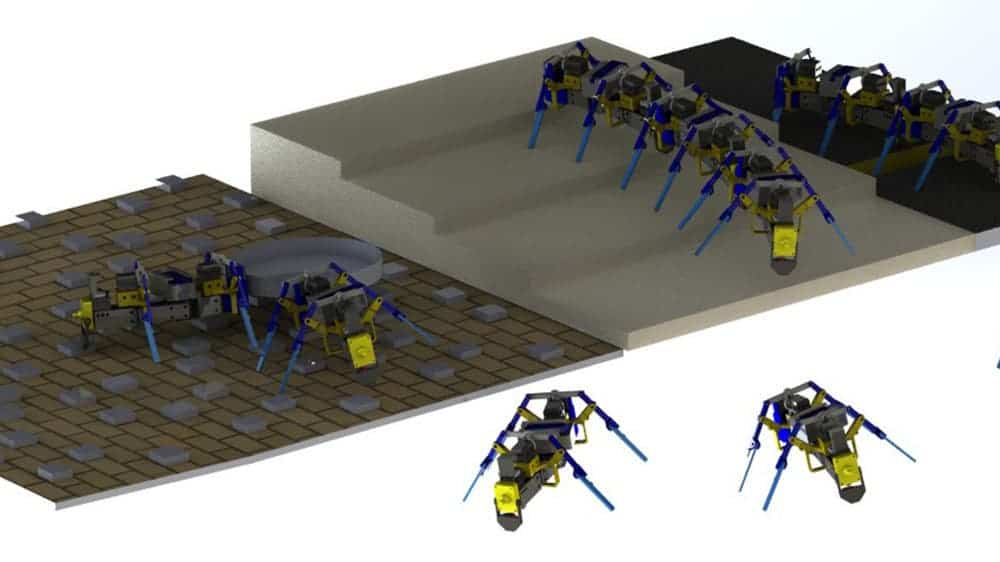Quantity is a quality all of its own, and that seems to be true in robotics, as well. Researchers at the University of Notre Dame report having successfully designed and built multi-legged robots that can navigate difficult terrain and work together to perform various tasks.

Nature is no stranger to the concept of cooperation. We ourselves are a great example of such cooperation at work, but insects such as ants and bees showcase what can be done when even tiny actors join hands. Roboticists have long been keen to mimic such abilities in their creations, and to instill them in small frames, especially.
New research places us squarely on the path towards such an objective.
Silicon swarm
“Legged robots can navigate challenging environments such as rough terrain and tight spaces, and the use of limbs offers effective body support, enables rapid maneuverability and facilitates obstacle crossing,” says Yasemin Ozkan-Aydin, an assistant professor of electrical engineering at the University of Notre Dame, who designed the robots.
“However, legged robots face unique mobility challenges in terrestrial environments, which results in reduced locomotor performance.”
The collective behavior of birds, ants, and other social insect species has been a great source of inspiration for Ozkan-Aydin. In particular, she was fascinated by their ability to work together to perform tasks that would be impossible for a single individual of the species to perform. She set out to try and instill the same capabilities in her own creations.
Although collective behaviors have been explored in flying and underwater robots, land-borne robots must contend with particular challenges that the other two do not. Traversing complex terrain, for example, is one such challenge.
Ozkan-Aydin started from the idea that a physical connection between individual bots could be used to enhance their overall mobility. The legged robots she designed will attempt to perform tasks such as moving a light object or navigating a smooth surface on their own but, if the task proves to be too great for them alone, several robots will physically connect to one another to form a larger, multi-legged system. Collectively, they will work to overcome the issue.
“When ants collect or transport objects, if one comes upon an obstacle, the group works collectively to overcome that obstacle. If there’s a gap in the path, for example, they will form a bridge so the other ants can travel across — and that is the inspiration for this study,” she said.
“Through robotics we’re able to gain a better understanding of the dynamics and collective behaviors of these biological systems and explore how we might be able to use this kind of technology in the future.”
Each individual bot measures around 15 to 20 centimeters (6 to 8 inches) in length, and they were built using a 3D printer. They carry their own lithium polymer battery, three sensors — a light sensor at the front and two magnetic touch sensors at the front and back, — and a microcontroller. The magnetic sensors allow them to connect to one another. They move around on four flexible legs, a setup that Ozkan-Aydin says reduces their need for sensors and their overall complexity.
She designed and built the robots in early 2020 and, due to the pandemic, much of her experimentation was performed at home or in her yard. During that time, the robots’ abilities were tested over grass, mulch, leaves, and acorns. Their abilities to cross flat surfaces were tested over particle board, stairs made from insulation foam, over a shaggy carpet, or over a particle board with rectangular wooden blocks glued on to simulate rough terrain.
During this time, Ozkan-Aydin programmed the robots so that when one of them became stuck, they would send a signal to the others to come to link up with it and help it traverse the obstacles together.
“You don’t need additional sensors to detect obstacles because the flexibility in the legs helps the robot to move right past them,” said Ozkan-Aydin. “They can test for gaps in a path, building a bridge with their bodies; move objects individually; or connect to move objects collectively in different types of environments, not dissimilar to ants.”
There are still improvements that can be made to the design, she explains. However, the intention wasn’t to design the perfect robot; what she hopes for is that her findings will help spur further development of low-cost, cooperative robots that can perform real-world tasks such as search-and-rescue operations, collective transport of various objects, environmental monitoring, or even space exploration. In the future, she will be focusing on improving the control, sensing abilities, and power autonomy of the robots.
“For functional swarm systems, the battery technology needs to be improved,” she said. “We need small batteries that can provide more power, ideally lasting more than 10 hours. Otherwise, using this type of system in the real world isn’t sustainable.”
“You need to think about how the robots would function in the real world, so you need to think about how much power is required, the size of the battery you use. Everything is limited so you need to make decisions with every part of the machine.”
The paper “Self-reconfigurable multilegged robot swarms collectively accomplish challenging terradynamic tasks” has been published in the journal Science Robotics.


